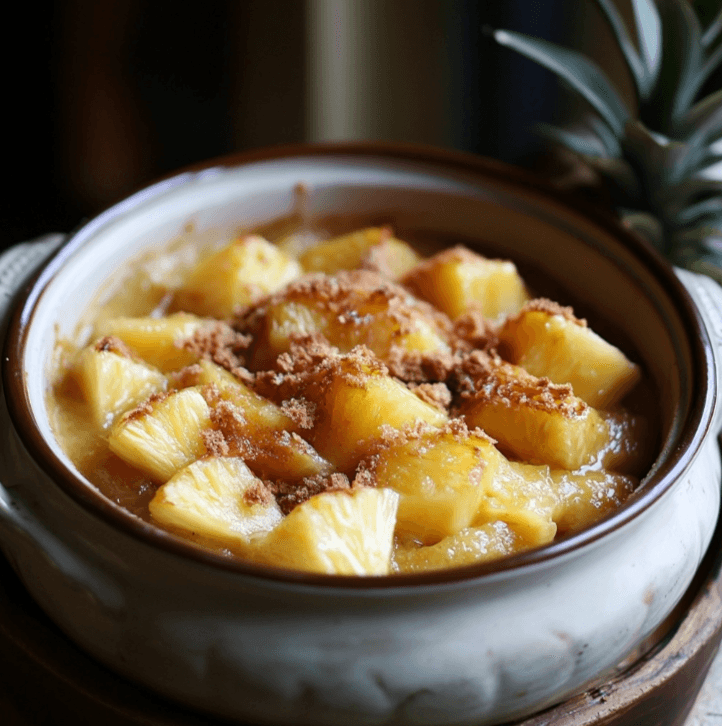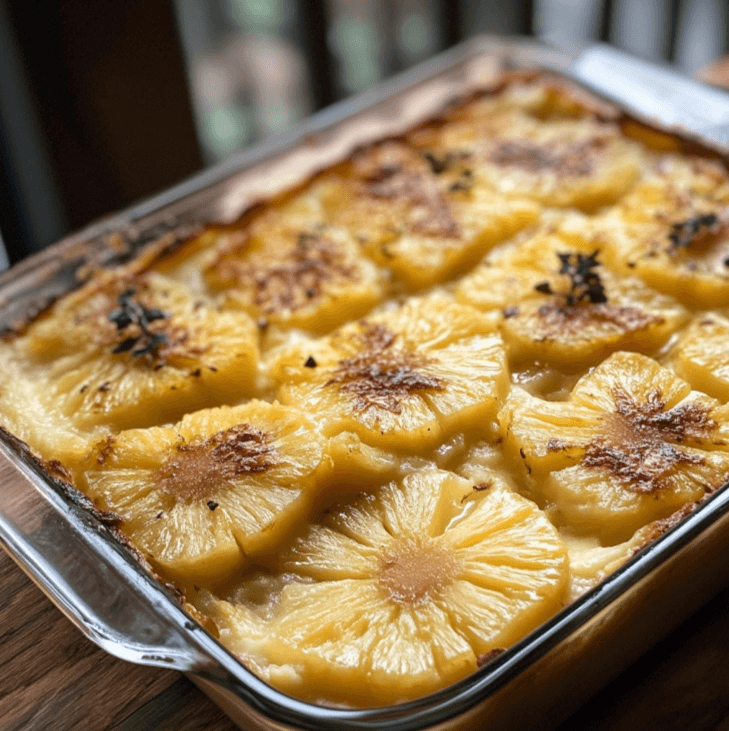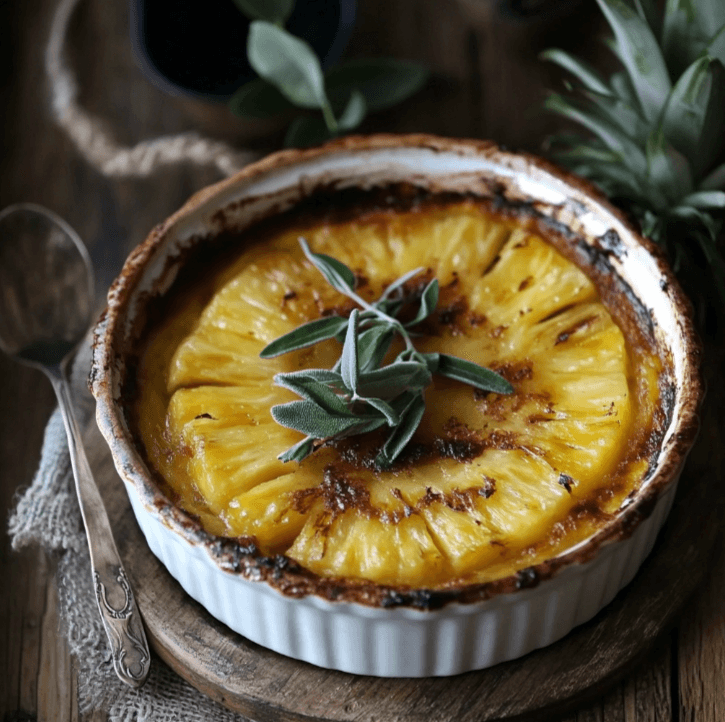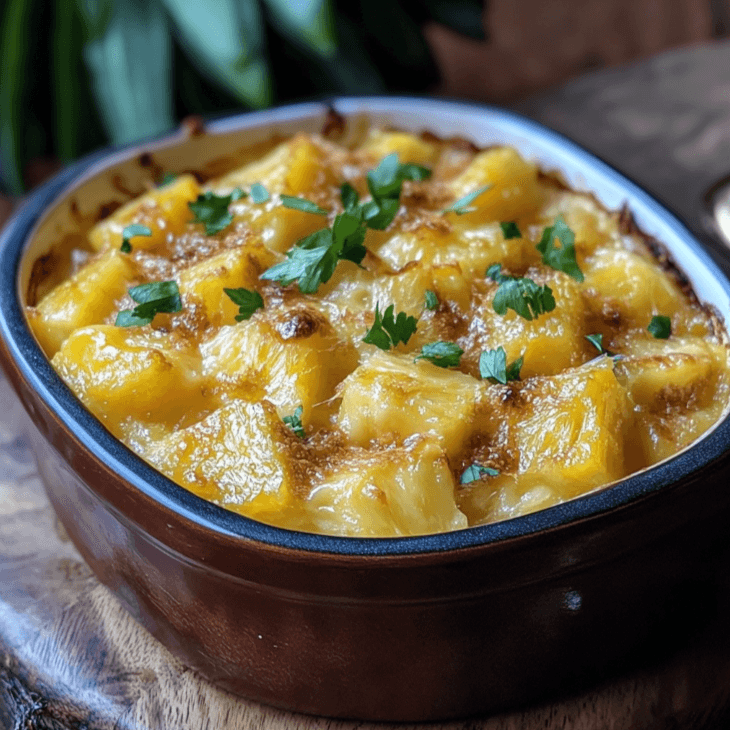Introduction
Pineapple casserole is a beloved dish that stands out for its unexpected blend of flavors and textures. Combining the sweetness of pineapple, the creaminess of cheese, and the crunch of buttery crackers, it’s a recipe that has captured the hearts of many, particularly in Southern kitchens. Perfect as a side dish, dessert, or even a unique potluck offering, pineapple casserole embodies the creativity and charm of home cooking.
In this guide, we’ll explore everything you need to know about pineapple casserole, from its intriguing history to practical tips for preparation. Whether you’re new to this dish or looking to perfect your recipe, you’ll find all the inspiration and information you need here.
Table of Contents

The Origins of Pineapple Casserole
Pineapple casserole is a testament to the ingenuity of Southern cooks who often embrace unexpected flavor combinations. The dish is believed to have originated in the Southern United States, where cooks merged pantry staples into surprisingly cohesive recipes. Pineapple, once considered an exotic and rare fruit, became more accessible in the early 20th century due to advancements in canning and transportation. Its sweet, tropical flavor quickly found a place in both savory and sweet dishes.
The combination of pineapple and cheese—a cornerstone of this casserole—may seem unusual at first glance. However, it’s rooted in the Southern tradition of blending sweet and savory elements, as seen in dishes like candied yams or sweet potato casserole with marshmallows. This casserole likely gained popularity through community cookbooks and church potlucks, where recipes were shared and adapted to suit regional preferences.
Today, pineapple casserole remains a cherished dish in Southern cuisine, often featured during holidays, family gatherings, and Sunday dinners. Its enduring appeal lies in its simplicity, affordability, and the nostalgia it evokes for many who grew up with its comforting flavors.
If you enjoy pineapple-based recipes, you may also appreciate this pineapple upside-down Bundt cake for dessert.
If you love comforting, crowd-pleasing casseroles, check out this Million Dollar Chicken Casserole for another rich and delicious dish.
Ingredients for Success
A standout pineapple casserole begins with a carefully chosen set of ingredients. Each plays a crucial role in creating the dish’s signature taste and texture. Here’s a closer look at what you’ll need:
Key Ingredients
- Pineapple
The star of the dish, canned pineapple chunks or tidbits, are typically used for convenience and consistency. Opt for pineapple packed in juice rather than syrup to control the sweetness. - Cheddar Cheese
Sharp cheddar cheese provides a tangy counterpoint to the pineapple’s sweetness. Grated cheese works best for even distribution. - Buttery Crackers
Crushed crackers, such as Ritz, add a salty, buttery crunch that contrasts beautifully with the creamy and sweet layers beneath. - Sugar
A small amount of sugar enhances the pineapple’s natural sweetness and balances the flavors. - All-Purpose Flour
Used as a thickening agent to create a cohesive mixture that holds together during baking. - Butter
Melted butter binds the cracker topping and imparts a rich, golden flavor to the crust.
Optional Add-Ins
- Cinnamon or Nutmeg: A dash of spice can add warmth and complexity.
- Crushed Pecans: For extra crunch and a nutty depth of flavor.
By assembling these ingredients with care, you set the stage for a dish that delivers on taste and texture with every bite.
How to Make Pineapple Casserole
Creating a pineapple casserole is a straightforward process that yields a dish bursting with flavor. Below is a comprehensive, step-by-step guide to preparing this Southern classic.
Ingredients Needed
Before you begin, gather the following ingredients:
- 2 (20-ounce) cans of pineapple chunks, drained (reserve ¼ cup juice)
- 1 cup granulated sugar
- 6 tablespoons all-purpose flour
- 2 cups sharp cheddar cheese, shredded
- 1 sleeve buttery crackers (e.g., Ritz), crushed
- ½ cup unsalted butter, melted
Step-by-Step Instructions
Step 1: Preheat the Oven
Set your oven to 350°F (175°C) and allow it to preheat while you prepare the casserole.
Step 2: Prepare the Pineapple Mixture
- In a mixing bowl, combine the drained pineapple chunks with the reserved ¼ cup of juice.
- Add the sugar and flour, stirring until the mixture is evenly coated.
- Fold in the shredded cheddar cheese to distribute it throughout the pineapple mixture.
Step 3: Assemble the Casserole
- Transfer the pineapple mixture to a greased 9×13-inch baking dish, spreading it evenly.
- In a separate bowl, mix the crushed buttery crackers with the melted butter until well combined.
- Sprinkle the cracker mixture evenly over the pineapple mixture, forming a crunchy topping.
Step 4: Bake the Casserole
Place the dish in the preheated oven and bake for 25–30 minutes, or until the topping is golden brown and the casserole is bubbling around the edges.
Step 5: Rest and Serve
Remove the casserole from the oven and let it rest for 5–10 minutes. This allows the layers to set and ensures clean servings.
For another Southern classic to complement your meal, check out this cheesy baked ziti with meat sauce.
Tips for Perfecting the Dish
While pineapple casserole is simple to prepare, a few expert tips can elevate it from good to extraordinary. Here are some ways to ensure your dish turns out perfectly every time.
Choose Quality Ingredients
- Pineapple: Opt for high-quality canned pineapple in juice for the best flavor. If you prefer fresh pineapple, ensure it’s fully ripe and cut into small chunks for consistency.
- Cheese: Use sharp cheddar cheese to provide a tangy contrast to the sweetness of the pineapple. Mild cheese may not deliver the same depth of flavor.
Perfect the Topping
- Cracker Crust: Crush the crackers finely for even coverage but leave some small chunks for added texture.
- Butter Ratio: Use just enough butter to bind the crackers without making the topping soggy. Aim for a golden, crispy finish.
Variations of Pineapple Casserole
One of the best things about pineapple casserole is its versatility. While the classic recipe is a crowd-pleaser, you can customize it to suit your preferences or experiment with unique twists. Below are some popular variations to try.
Sweet Variations
- Pineapple Dessert Casserole
Swap the cheddar cheese for cream cheese or mascarpone to create a sweeter, dessert-focused dish. - Tropical Delight
Incorporate additional tropical fruits like mango or shredded coconut for a richer island-inspired flavor. Use graham cracker crumbs in place of buttery crackers.

FAQs About Pineapple Casserole
To help you master the art of making and serving pineapple casserole, here are answers to some of the most frequently asked questions about this beloved dish.
Can I Use Fresh Pineapple Instead of Canned?
Yes, fresh pineapple can be used as a substitute for canned pineapple. However, ensure the pineapple is fully ripe to maintain the dish’s sweet flavor. Since fresh pineapple has a higher water content, drain it thoroughly or pat it dry with paper towels to avoid a watery casserole.
For a dessert option that also highlights fresh fruit, consider this tropical mango pineapple delight, which pairs beautifully with the casserole.
Can I Make Pineapple Casserole Ahead of Time?
Absolutely! Pineapple casserole is an excellent make-ahead dish. Assemble it up to 24 hours in advance, cover tightly with plastic wrap or aluminum foil, and store it in the refrigerator. When ready to serve, bake as directed, adding 5–10 minutes to the cooking time to account for the chilled ingredients.
For other make-ahead dishes that complement this recipe, try these cheesy baked ziti with meat sauce or garlic bread smashed potatoes.
How Should I Store Leftovers?
Leftover pineapple casserole can be stored in an airtight container in the refrigerator for up to 3 days. Reheat in a 350°F oven for 10–15 minutes, or microwave individual portions until warmed through. To keep the topping crispy, reheat in the oven whenever possible.
For a creative twist on leftovers, use your reheated pineapple casserole as a topping for waffles or pancakes, as suggested in this pancake recipe guide.
Can I Freeze Pineapple Casserole?
Yes, pineapple casserole can be frozen, but there are a few considerations. Freeze it before baking to preserve the texture of the topping. Wrap the assembled casserole tightly in plastic wrap and aluminum foil, then store it in the freezer for up to 3 months. When ready to bake, thaw overnight in the refrigerator and bake as directed.
Looking for freezer-friendly dessert ideas? Try these rich pecan pie bars, which freeze well and complement the casserole’s tropical flavors.
Is Pineapple Casserole Vegetarian-Friendly?
Most versions of pineapple casserole are vegetarian, as they do not contain meat. To ensure it meets vegetarian standards, verify that the crackers and cheese used in the recipe do not contain animal-derived additives like rennet.
If you’re hosting vegetarian guests, pair the casserole with this cream of broccoli soup for a hearty and satisfying meal.
Can I reduce the sugar in the recipe?
Yes, you can adjust the sugar content to your taste. For a less sweet version, reduce the sugar by half or omit it entirely if using naturally sweet pineapple. Consider using sugar substitutes like stevia or monk fruit for a low-sugar alternative.
For those seeking additional low-sugar recipes, check out this guide to healthier desserts with reduced sugar.
What Are Some Creative Ways to Serve Pineapple Casserole?
Pineapple casserole is incredibly versatile and can be served in a variety of creative ways. Here are some ideas:
- As a Topping: Use it as a topping for vanilla ice cream or pancakes for a dessert twist.
- In Sandwiches: Add a spoonful of pineapple casserole to a ham or turkey sandwich for a sweet-savory combo.
- With Grains: Serve it over cooked rice or quinoa for a unique side dish.
For more creative serving suggestions, explore this list of unexpected pairings.
Why Do Pineapple and Cheese Work Together?
The combination of pineapple and cheese works because of the balance between contrasting flavors and textures. The sweetness and acidity of pineapple complement the creamy, salty sharpness of cheddar cheese. Together, they create a dish that’s both harmonious and unexpected.
If you’re curious about other unconventional flavor pairings, read about how sweet and savory flavors collide in these tropical-inspired recipes.
Additional Pro Tips
Here are some extra tips to take your pineapple casserole to the next level:
- Upgrade the Topping: Experiment with crushed pretzels or graham crackers for an alternative crust.
- Add Herbs: Incorporate a touch of rosemary or thyme for a subtle savory twist.
- Infuse Spices: Add a pinch of cardamom or ginger for a warm and aromatic depth.
For advanced tips on topping variations, explore this pecan-inspired crust guide.
Conclusion

Pineapple casserole is a delightful dish that brings together an unexpected yet perfectly balanced combination of sweet and savory flavors. With its origins rooted in Southern cuisine, this recipe has stood the test of time, becoming a cherished favorite for holidays, potlucks, and family gatherings alike. Its simplicity, versatility, and rich taste make it a must-try dish for both seasoned cooks and kitchen novices.
Whether you stick with the classic recipe or experiment with creative variations, pineapple casserole is guaranteed to impress your guests and bring a touch of warmth to any meal. From its crispy cracker topping to the luscious blend of pineapple and cheese, every bite delivers a comforting and unique culinary experience.
Pair it with hearty sides like cheesy baked ziti or light starters like cream of broccoli soup to create a balanced and unforgettable menu.
So, gather your ingredients, preheat your oven, and give this iconic dish a try. Whether served as a side, dessert, or stand-alone treat, pineapple casserole is sure to become a staple in your recipe collection. Happy cooking!

